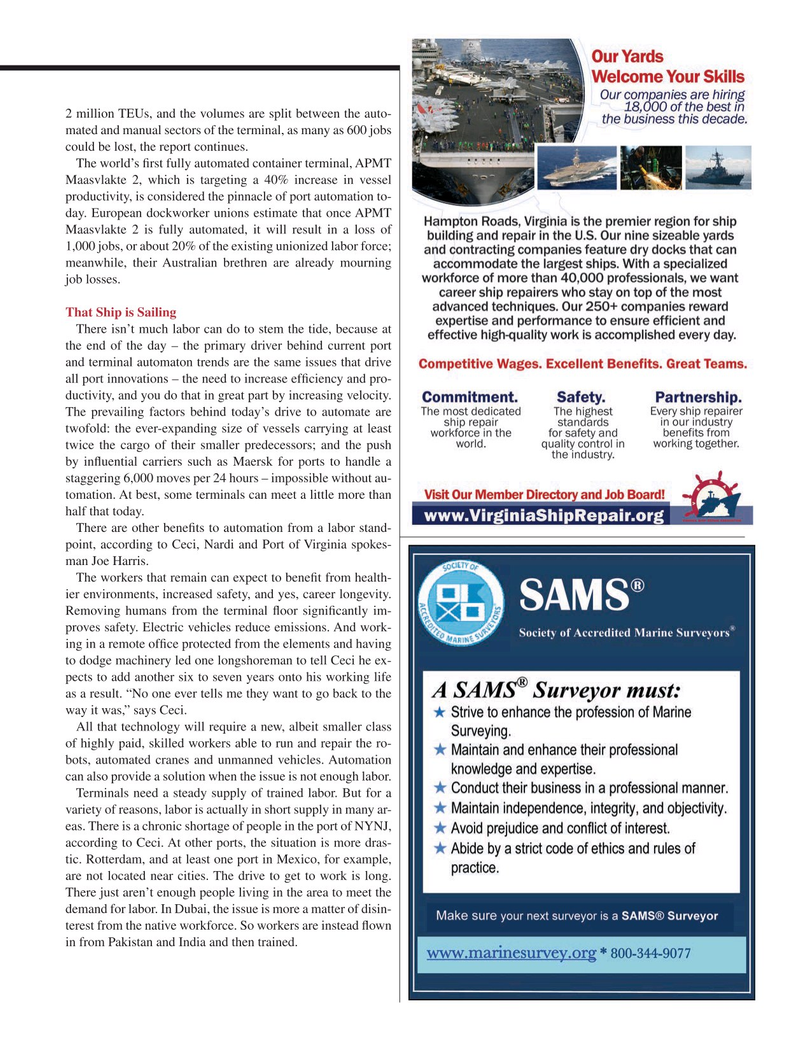
Page 31: of Maritime Logistics Professional Magazine (Q3 2015)
Read this page in Pdf, Flash or Html5 edition of Q3 2015 Maritime Logistics Professional Magazine
2 million TEUs, and the volumes are split between the auto- mated and manual sectors of the terminal, as many as 600 jobs could be lost, the report continues.
The world’s ? rst fully automated container terminal, APMT
Maasvlakte 2, which is targeting a 40% increase in vessel productivity, is considered the pinnacle of port automation to- day. European dockworker unions estimate that once APMT
Maasvlakte 2 is fully automated, it will result in a loss of 1,000 jobs, or about 20% of the existing unionized labor force; meanwhile, their Australian brethren are already mourning job losses.
That Ship is Sailing
There isn’t much labor can do to stem the tide, because at the end of the day – the primary driver behind current port and terminal automaton trends are the same issues that drive all port innovations – the need to increase ef? ciency and pro- ductivity, and you do that in great part by increasing velocity.
The prevailing factors behind today’s drive to automate are twofold: the ever-expanding size of vessels carrying at least twice the cargo of their smaller predecessors; and the push by in? uential carriers such as Maersk for ports to handle a staggering 6,000 moves per 24 hours – impossible without au- tomation. At best, some terminals can meet a little more than half that today.
There are other bene? ts to automation from a labor stand- point, according to Ceci, Nardi and Port of Virginia spokes- man Joe Harris.
The workers that remain can expect to bene? t from health- ier environments, increased safety, and yes, career longevity.
Removing humans from the terminal ? oor signi? cantly im- proves safety. Electric vehicles reduce emissions. And work- ing in a remote of? ce protected from the elements and having to dodge machinery led one longshoreman to tell Ceci he ex- pects to add another six to seven years onto his working life as a result. “No one ever tells me they want to go back to the way it was,” says Ceci.
All that technology will require a new, albeit smaller class of highly paid, skilled workers able to run and repair the ro- bots, automated cranes and unmanned vehicles. Automation can also provide a solution when the issue is not enough labor.
Terminals need a steady supply of trained labor. But for a variety of reasons, labor is actually in short supply in many ar- eas. There is a chronic shortage of people in the port of NYNJ, according to Ceci. At other ports, the situation is more dras- tic. Rotterdam, and at least one port in Mexico, for example, are not located near cities. The drive to get to work is long.
There just aren’t enough people living in the area to meet the demand for labor. In Dubai, the issue is more a matter of disin- terest from the native workforce. So workers are instead ? own in from Pakistan and India and then trained. 18-33 Q3 MP2015.indd 31 9/18/2015 9:52:03 AM

 30
30

 32
32
